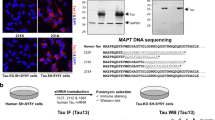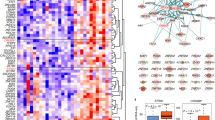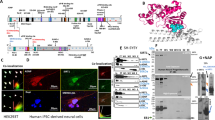Abstract
The microtubule-associated protein tau is involved in a number of neurodegenerative disorders, including Alzheimer's disease. Previous studies have linked oxidative stress and subsequent DNA damage to neuronal death in Alzheimer's disease and related tauopathies. Given that DNA damage can substantially alter chromatin structure, we examined epigenetic changes in tau-induced neurodegeneration. We found widespread loss of heterochromatin in tau transgenic Drosophila and mice and in human Alzheimer's disease. Notably, genetic rescue of tau-induced heterochromatin loss substantially reduced neurodegeneration in Drosophila. We identified oxidative stress and subsequent DNA damage as a mechanistic link between transgenic tau expression and heterochromatin relaxation, and found that heterochromatin loss permitted aberrant gene expression in tauopathies. Furthermore, large-scale analyses from the brains of individuals with Alzheimer's disease revealed a widespread transcriptional increase in genes that were heterochromatically silenced in controls. Our results establish heterochromatin loss as a toxic effector of tau-induced neurodegeneration and identify chromatin structure as a potential therapeutic target in Alzheimer's disease.
This is a preview of subscription content, access via your institution
Access options
Subscribe to this journal
Receive 12 print issues and online access
$209.00 per year
only $17.42 per issue
Buy this article
- Purchase on Springer Link
- Instant access to full article PDF
Prices may be subject to local taxes which are calculated during checkout






Similar content being viewed by others
Accession codes
References
Lee, V.M., Goedert, M. & Trojanowski, J.Q. Neurodegenerative tauopathies. Annu. Rev. Neurosci. 24, 1121–1159 (2001).
Hutton, M. et al. Association of missense and 5′-splice-site mutations in tau with the inherited dementia FTDP-17. Nature 393, 702–705 (1998).
Poorkaj, P. et al. Tau is a candidate gene for chromosome 17 frontotemporal dementia. Ann. Neurol. 43, 815–825 (1998).
Spillantini, M.G., Crowther, R.A., Kamphorst, W., Heutink, P. & van Swieten, J.C. Tau pathology in two Dutch families with mutations in the microtubule-binding region of tau. Am. J. Pathol. 153, 1359–1363 (1998).
Holtzman, D.M., Mandelkow, E. & Selkoe, D.J. Alzheimer disease in 2020. Cold Spring Harb. Perspect. Med. 2, a011585 (2012).
Kruman, I.I. et al. Cell cycle activation linked to neuronal cell death initiated by DNA damage. Neuron 41, 549–561 (2004).
Khurana, V. et al. TOR-mediated cell-cycle activation causes neurodegeneration in a Drosophila tauopathy model. Curr. Biol. 16, 230–241 (2006).
Khurana, V. et al. A neuroprotective role for the DNA damage checkpoint in tauopathy. Aging Cell 11, 360–362 (2012).
Blard, O. et al. Cytoskeleton proteins are modulators of mutant tau-induced neurodegeneration in Drosophila. Hum. Mol. Genet. 16, 555–566 (2007).
Ambegaokar, S.S. & Jackson, G.R. Functional genomic screen and network analysis reveal novel modifiers of tauopathy dissociated from tau phosphorylation. Hum. Mol. Genet. 20, 4947–4977 (2011).
Smith, K.T. & Workman, J.L. Chromatin proteins: key responders to stress. PLoS Biol. 10, e1001371 (2012).
Dillon, N. Heterochromatin structure and function. Biol. Cell 96, 631–637 (2004).
Peng, J.C. & Karpen, G.H. Heterochromatic genome stability requires regulators of histone H3 K9 methylation. PLoS Genet. 5, e1000435 (2009).
De Lucia, F., Ni, J.Q., Vaillant, C. & Sun, F.L. HP1 modulates the transcription of cell-cycle regulators in Drosophila melanogaster. Nucleic Acids Res. 33, 2852–2858 (2005).
Wittmann, C.W. et al. Tauopathy in Drosophila: neurodegeneration without neurofibrillary tangles. Science 293, 711–714 (2001).
Dias-Santagata, D., Fulga, T.A., Duttaroy, A. & Feany, M.B. Oxidative stress mediates tau-induced neurodegeneration in Drosophila. J. Clin. Invest. 117, 236–245 (2007).
Steinhilb, M.L., Dias-Santagata, D., Fulga, T.A., Felch, D.L. & Feany, M.B. Tau phosphorylation sites work in concert to promote neurotoxicity in vivo. Mol. Biol. Cell 18, 5060–5068 (2007).
Fulga, T.A. et al. Abnormal bundling and accumulation of F-actin mediates tau-induced neuronal degeneration in vivo. Nat. Cell Biol. 9, 139–148 (2007).
Lu, B.Y., Ma, J. & Eissenberg, J.C. Developmental regulation of heterochromatin-mediated gene silencing in Drosophila. Development 125, 2223–2234 (1998).
Paredes, S. & Maggert, K.A. Ribosomal DNA contributes to global chromatin regulation. Proc. Natl. Acad. Sci. USA 106, 17829–17834 (2009).
Williams, D.W., Kondo, S., Krzyzanowska, A., Hiromi, Y. & Truman, J.W. Local caspase activity directs engulfment of dendrites during pruning. Nat. Neurosci. 9, 1234–1236 (2006).
Beisel, C., Imhof, A., Greene, J., Kremmer, E. & Sauer, F. Histone methylation by the Drosophila epigenetic transcriptional regulator Ash1. Nature 419, 857–862 (2002).
Tsukiyama, T. & Wu, C. Purification and properties of an ATP-dependent nucleosome remodeling factor. Cell 83, 1011–1020 (1995).
Hensley, K. et al. Electrochemical analysis of protein nitrotyrosine and dityrosine in the Alzheimer brain indicates region-specific accumulation. J. Neurosci. 18, 8126–8132 (1998).
Mullaart, E., Boerrigter, M.E., Ravid, R., Swaab, D.F. & Vijg, J. Increased levels of DNA breaks in cerebral cortex of Alzheimer's disease patients. Neurobiol. Aging 11, 169–173 (1990).
Missirlis, F. et al. Mitochondrial and cytoplasmic thioredoxin reductase variants encoded by a single Drosophila gene are both essential for viability. J. Biol. Chem. 277, 11521–11526 (2002).
Marygold, S.J. et al. FlyBase: improvements to the bibliography. Nucleic Acids Res. 41, D751–D757 (2013).
Hittelman, W.N. & Pollard, M. Visualization of chromatin events associated with repair of ultraviolet light-induced damage by premature chromosome condensation. Carcinogenesis 5, 1277–1285 (1984).
Rubbi, C.P. & Milner, J. p53 is a chromatin accessibility factor for nucleotide excision repair of DNA damage. EMBO J. 22, 975–986 (2003).
Kent, W.J. et al. The human genome browser at UCSC. Genome Res. 12, 996–1006 (2002).
Celniker, S.E. et al. Unlocking the secrets of the genome. Nature 459, 927–930 (2009).
Brennecke, J. et al. Discrete small RNA-generating loci as master regulators of transposon activity in Drosophila. Cell 128, 1089–1103 (2007).
Aravin, A. et al. A novel class of small RNAs bind to MILI protein in mouse testes. Nature 442, 203–207 (2006).
Girard, A., Sachidanandam, R., Hannon, G.J. & Carmell, M.A. A germline-specific class of small RNAs binds mammalian Piwi proteins. Nature 442, 199–202 (2006).
Lewis, J. et al. Neurofibrillary tangles, amyotrophy and progressive motor disturbance in mice expressing mutant (P301L) tau protein. Nat. Genet. 25, 402–405 (2000).
Edwards, T.N. & Meinertzhagen, I.A. The functional organisation of glia in the adult brain of Drosophila and other insects. Prog. Neurobiol. 90, 471–497 (2010).
Bernstein, B.E. et al. The NIH Roadmap Epigenomics Mapping Consortium. Nat. Biotechnol. 28, 1045–1048 (2010).
Ernst, J. & Kellis, M. ChromHMM: automating chromatin-state discovery and characterization. Nat. Methods 9, 215–216 (2012).
Blalock, E.M. et al. Incipient Alzheimer's disease: microarray correlation analyses reveal major transcriptional and tumor suppressor responses. Proc. Natl. Acad. Sci. USA 101, 2173–2178 (2004).
Zhu, J. et al. Genome-wide chromatin state transitions associated with developmental and environmental cues. Cell 152, 642–654 (2013).
Cooper-Knock, J. et al. Gene expression profiling in human neurodegenerative disease. Nat. Rev. Neurol. 8, 518–530 (2012).
Ittner, L.M. & Gotz, J. Amyloid-beta and tau–a toxic pas de deux in Alzheimer's disease. Nat. Rev. Neurosci. 12, 65–72 (2011).
Frost, B., Jacks, R.L. & Diamond, M.I. Propagation of tau misfolding from the outside to the inside of a cell. J. Biol. Chem. 284, 12845–12852 (2009).
DuBoff, B., Gotz, J. & Feany, M.B. Tau promotes neurodegeneration via DRP1 mislocalization in vivo. Neuron 75, 618–632 (2012).
Bosch-Presegué, L. et al. Stabilization of Suv39H1 by SirT1 is part of oxidative stress response and ensures genome protection. Mol. Cell 42, 210–223 (2011).
Krylova, S.M. et al. Tau protein binds single-stranded DNA sequence specifically—the proof obtained in vitro with non-equilibrium capillary electrophoresis of equilibrium mixtures. FEBS Lett. 579, 1371–1375 (2005).
Sjöberg, M.K., Shestakova, E., Mansuroglu, Z., Maccioni, R.B. & Bonnefoy, E. Tau protein binds to pericentromeric DNA: a putative role for nuclear tau in nucleolar organization. J. Cell Sci. 119, 2025–2034 (2006).
Wei, Y. et al. Binding to the minor groove of the double-strand, tau protein prevents DNA from damage by peroxidation. PLoS ONE 3, e2600 (2008).
Faghihi, M.A. et al. Expression of a noncoding RNA is elevated in Alzheimer's disease and drives rapid feed-forward regulation of beta-secretase. Nat. Med. 14, 723–730 (2008).
Juliano, C., Wang, J. & Lin, H. Uniting germline and stem cells: the function of Piwi proteins and the piRNA pathway in diverse organisms. Annu. Rev. Genet. 45, 447–469 (2011).
Schwartz, Y.B. et al. Genome-wide analysis of Polycomb targets in Drosophila melanogaster. Nat. Genet. 38, 700–705 (2006).
Gelbart, M.E., Larschan, E., Peng, S., Park, P.J. & Kuroda, M.I. Drosophila MSL complex globally acetylates H4K16 on the male X chromosome for dosage compensation. Nat. Struct. Mol. Biol. 16, 825–832 (2009).
Langmead, B., Trapnell, C., Pop, M. & Salzberg, S.L. Ultrafast and memory-efficient alignment of short DNA sequences to the human genome. Genome Biol. 10, R25 (2009).
Penna, I. et al. Selection of candidate housekeeping genes for normalization in human postmortem brain samples. Int. J. Mol. Sci. 12, 5461–5470 (2011).
Jiang, Y., Matevossian, A., Huang, H.S., Straubhaar, J. & Akbarian, S. Isolation of neuronal chromatin from brain tissue. BMC Neurosci. 9, 42 (2008).
Berzsenyi, M.D. et al. Down-regulation of intra-hepatic T-cell signaling associated with GB virus C in a HCV/HIV co-infected group with reduced liver disease. J. Hepatol. 55, 536–544 (2011).
Maes, O.C. et al. Transcriptional profiling of Alzheimer blood mononuclear cells by microarray. Neurobiol. Aging 28, 1795–1809 (2007).
Reimand, J., Kull, M., Peterson, H., Hansen, J. & Vilo, J. g:Profiler—a web-based toolset for functional profiling of gene lists from large-scale experiments. Nucleic Acids Res. 35, W193–W200 (2007).
Martens, G.A. et al. Clusters of conserved beta cell marker genes for assessment of beta cell phenotype. PLoS ONE 6, e24134 (2011).
Acknowledgements
A. Alekseyenko, N. Riddle and A. Minoda provided critical advice for the H3K9me2 ChIP experiments. J. Eissenberg (Saint Louis University School of Medicine), K. Maggert (Texas A&M University), J. Brennecke (Austrian Academy of Science) and F. Missirlis (National Polytechnic Institute) provided Drosophila stocks. We thank C. Lemere (Brigham and Women's Hospital), D. Borchelt and G. Xu (University of Florida) for generously providing important reagents. We performed confocal imaging at the Harvard NeuroDiscovery Center Enhanced Neuroimaging Core Facility. The TRiP at Harvard Medical School (NIH/HIGMS R01-GM084947) and the Vienna Drosophila RNAi Center provided transgenic RNAi fly stocks. Antibodies obtained from the Developmental Studies Hybridoma Bank were developed under the auspices of the National Institute of Child Health and Human Development and maintained by the University of Iowa. Antibodies obtained from the University of California Davis/US National Institutes of Health NeuroMab facility are supported by NIH grant U24NS050606 and maintained by the University of California Davis. This work was supported by a Ruth L. Kirschstein National Research Service Award F32AG039193 (B.F.), R01AG33518, a Senior Scholar Award from the Ellison Medical Foundation and a grant from the American Health Assistance Foundation/BrightFocus (M.B.F.), and US National Institutes of Health (1R21NS070250) and National Science Foundation grants (0954570) in support of M.H. Support was provided to J.L. through the University of Florida Department of Neuroscience.
Author information
Authors and Affiliations
Contributions
B.F. and M.B.F. conceptualized the study. B.F. performed experiments and ChIP-seq analysis. M.H. performed human expression analysis, principal component analysis and provided guidance for ChIP-seq analysis. J.L. provided critical reagents and contributed to research design. B.F., M.B.F. and M.H. participated in interpreting data and wrote the manuscript. M.B.F. supervised the research.
Corresponding author
Ethics declarations
Competing interests
The authors declare no competing financial interests.
Integrated supplementary information
Supplementary Figure 1 Heterochromatin in wild-type tau or pseudohyperphosphorylated tau transgenic Drosophila, Drosophila harboring mutations in or RNAi-mediated reduction of chromatin modifying genes, and tau phosphorylation in the context of chromatin modifiers.
(a) Su(var)3-9 and Su(var)205 mRNA levels in tau transgenic flies, n = 3 trials, 10 heads per trial. (b) H3K9me2 and HP1α levels in homogenates from fly heads transgenic for human wild type tau (tauWT) or pseudohyperphosphorylated tau (tauE14). Full-length blots are shown in Supplementary Fig. 6a. (c) Quantification of b, n = 7 heads (for H3K9me2, *p = 0.04, F = 4.39, for HP1α, **p = 0.001, F = 12.26, six degrees of freedom, one-way ANOVA). (d) H3K9me2- and HP1α-staining in control and tau transgenic brains based on DAB staining, n = 3 brains. Arrows indicate a nucleus with typical focal chromocenter labeling; arrowheads indicate a nucleus lacking focal chromocenter labeling. The region presented is cortex. Scale bar is 10 μm. (e) Quantification of β-galactosidase reporter activation in control, tauWT and tauE14 transgenic fly brains. Control is elav-GAL4/BL2, n = 6 brains, p < 0.001, F = 198.54 for five degrees of freedom, one-way ANOVA. (f) H3K9me2 and HP1α levels in homogenates from heads of control flies heterozygous for a loss-of-function mutation in ash1 or expressing an RNAi transgene targeted to NURF301. Full-length blots are shown in Supplementary Fig. 6b. (g) Quantification of f, n = 3 heads. (h) mRNA levels of ash1, NURF38, and NURF301 in tau transgenic Drosophila, compared to control, n = 3 trials, 10 heads per trial. (i) RT-PCR of ash1, NURF38, and NURF301 in flies harboring RNAi transgenes targeted to ash1, NURF38, and NURF301, n = 3, 10 heads per trial, *p = 0.02, F = 5.86 for two degrees of freedom, one-way ANOVA. H3K9me2 and HP1α levels in homogenates from heads of control flies heterozygous for loss-of-function mutations in Su(var)205 or Su(var)3-9 (j, quantified in k, n = 3 heads). Full-length blots are shown in Supplementary Fig. 6c. (l) Total tau levels and tau phosphorylation in homogenates from heads of tau transgenic flies with the indicated transgenes at 1 day, n = 3 heads. Full-length blots are shown in Supplementary Fig. 6d. Flies are 10 days old unless otherwise specified. Controls are elav-GAL4/+. Data are mean ± s.e.m.
Supplementary Figure 2 Efficiency of RNAi-mediated knockdown of gene expression, and tau phosphorylation in the context of RNAi-mediated reduction of Ago3 in Drosophila.
(a) mRNA levels of Su(var)205 and Su(var)3-9 in flies with Su(var)205 and Su(var)3-9 RNAi transgenes, n = 3 trials, 10 heads per trial, **p < 0.001, F = 56.07 for two degrees of freedom, one-way ANOVA. (b) Tau levels and phosphorylation in homogenates from heads of tau transgenic flies with RNAi mediated reduction of Ago3, n = 3 heads. Full blots are shown in Supplementary Fig. 6e. (c) Ago3 mRNA levels in 1 day old flies harboring RNAi transgenes targeted to Ago3, n = 3 trials, 10 heads per trial, **p = 0.002, F = 21.53 for two degrees of freedom, one-way ANOVA. Control is elav-GAL4/+. Flies are 1 day old. Data are mean ± s.e.m.
Supplementary Figure 3 Heterochromatin and gene expression changes in human AD.
(a) HP1α and AT8 immunostaining in human AD hippocampal neurons. Arrowheads indicate AT8 negative neurons and arrows indicate AT8 positive neurons. Upper boxes are higher magnifications of HP1α staining in AT8 negative or AT8 positive neurons, n = 6 brains. (b) Publicly available histone modification data used to define chromatin states. Average mRNA levels of heterochromatic (c) and euchromatic (d) genes from liver biopsies of HIV positive patients with and without GB virus C infection. Gray lines indicate 50% gene expression change threshold. (e) Principal component analysis of AD (n = 10) and control (n = 13) laser captured hippocampal neurons, hippocampi from control (n = 9) and three stages of AD (incipient (n = 7), moderate (n = 8), and severe (n = 7)), and fetal brain (n = 2), yellow box indicates principal component 4, which groups AD hippocampal neurons, severe AD hippocampi, and fetal brain. Average mRNA levels of heterochromatic (f) and euchromatic (g) genes in peripheral blood mononuclear cells (BMC) from control and AD (n = 14) patients. (h) Bar plot of genes from f and g with expression changes greater than 50%. For increased expression of genes in AD that are classified as heterochromatic and expressed at low levels in control, p < 0.0002, chi-square. Error bars in h reflect standard deviation from 1,000 bootstraps.
Supplementary Figure 4 Working model of tau-induced neurodegeneration.
In neurons affected by tauopathies, tau aggregation and/or aberrant phosphorylation causes oxidative DNA damage, which is one mechanism whereby tau induces relaxation of heterochromatin. Heterochromatin loss permits aberrant expression of genes, particularly those genes associated with development, which induces dedifferentiation of neurons toward a more stem cell-like state. Neuronal dedifferentiation then triggers aberrant cell cycle activation and subsequent apoptosis.
Supplementary information
Supplementary Text and Figures
Supplementary Figures 1–6 and Supplementary Tables 1–4 (PDF 1902 kb)
Supplementary Data Set 1
Chromatin states within the human hippocampus. (PDF 123562 kb)
Supplementary Data Set 2
List of genes that are heterochromatically silenced in control human hippocampal neurons and are expressed at least 50% higher in AD hippocampal neurons. (PDF 925 kb)
Supplementary Data Set 3
List of genes that are heterochromatically silenced in control peripheral blood mononuclear cells and expressed at least 50% higher in AD peripheral blood mononuclear cells. (PDF 380 kb)
Rights and permissions
About this article
Cite this article
Frost, B., Hemberg, M., Lewis, J. et al. Tau promotes neurodegeneration through global chromatin relaxation. Nat Neurosci 17, 357–366 (2014). https://doi.org/10.1038/nn.3639
Received:
Accepted:
Published:
Issue Date:
DOI: https://doi.org/10.1038/nn.3639
This article is cited by
-
Nuclear face of Tau: an inside player in neurodegeneration
Acta Neuropathologica Communications (2023)
-
Does modulation of tau hyperphosphorylation represent a reasonable therapeutic strategy for Alzheimer’s disease? From preclinical studies to the clinical trials
Molecular Psychiatry (2023)
-
Development of an accelerated cellular model for early changes in Alzheimer’s disease
Scientific Reports (2023)
-
JUN upregulation drives aberrant transposable element mobilization, associated innate immune response, and impaired neurogenesis in Alzheimer’s disease
Nature Communications (2023)
-
A Drosophila model relevant to chemotherapy-related cognitive impairment
Scientific Reports (2023)



